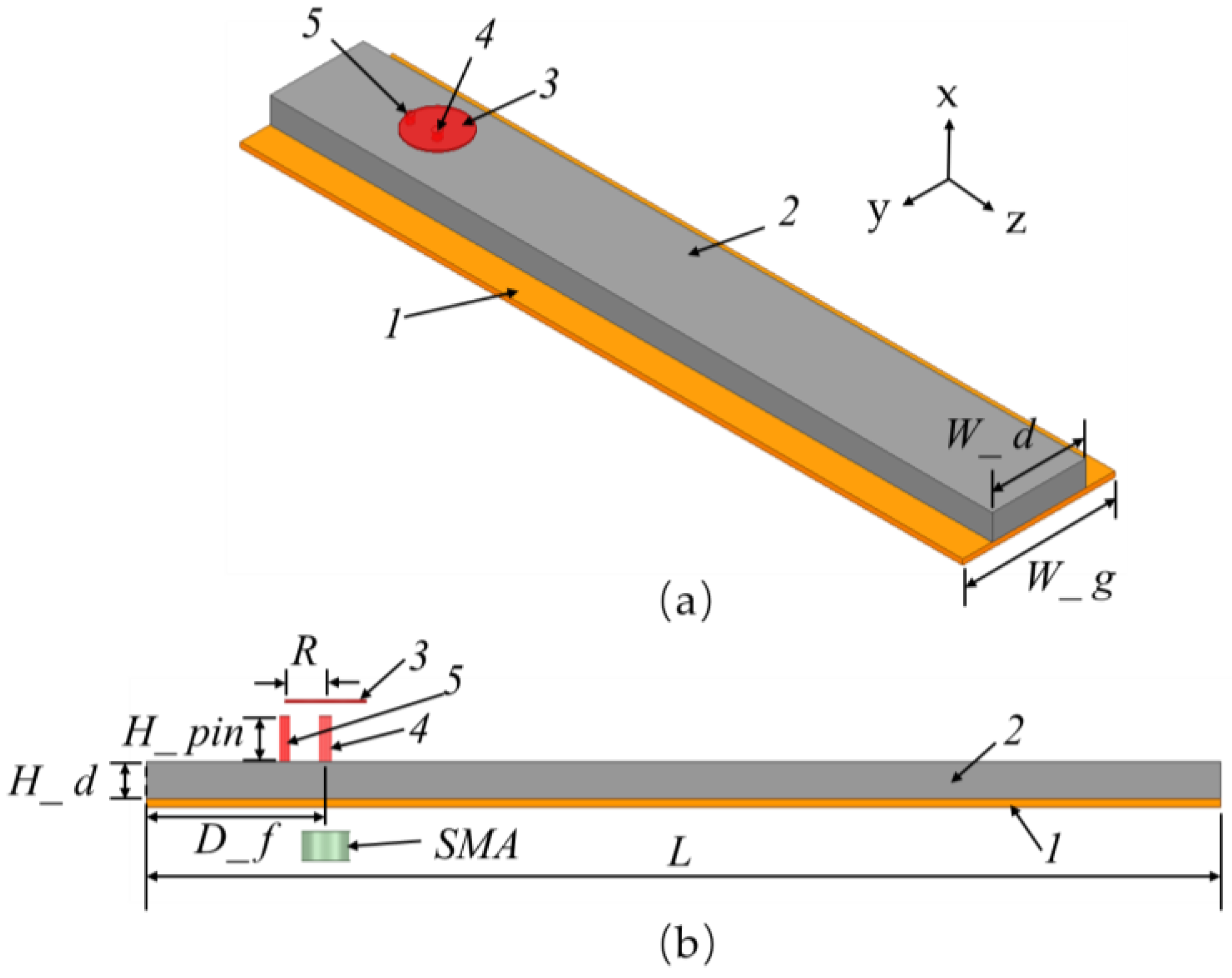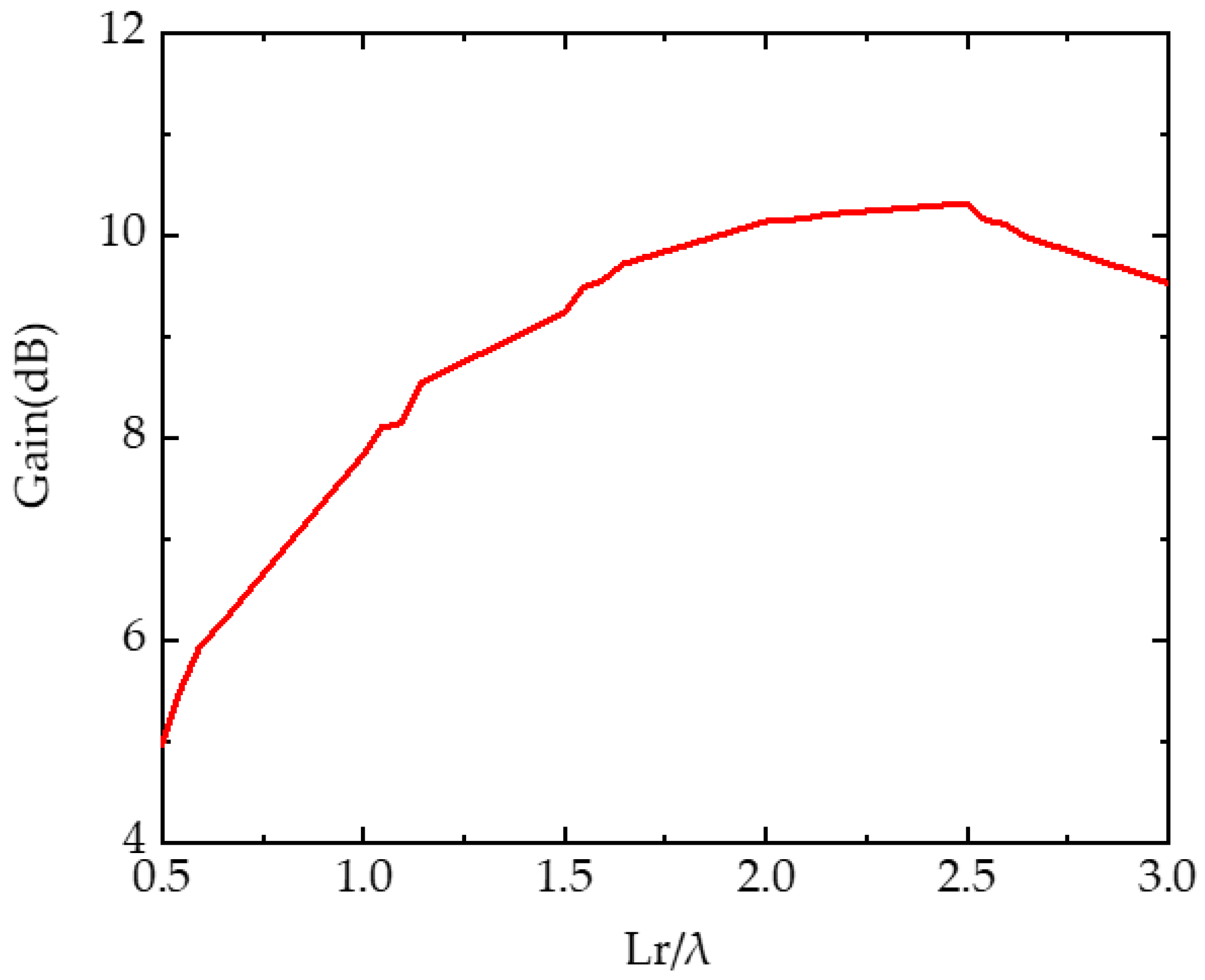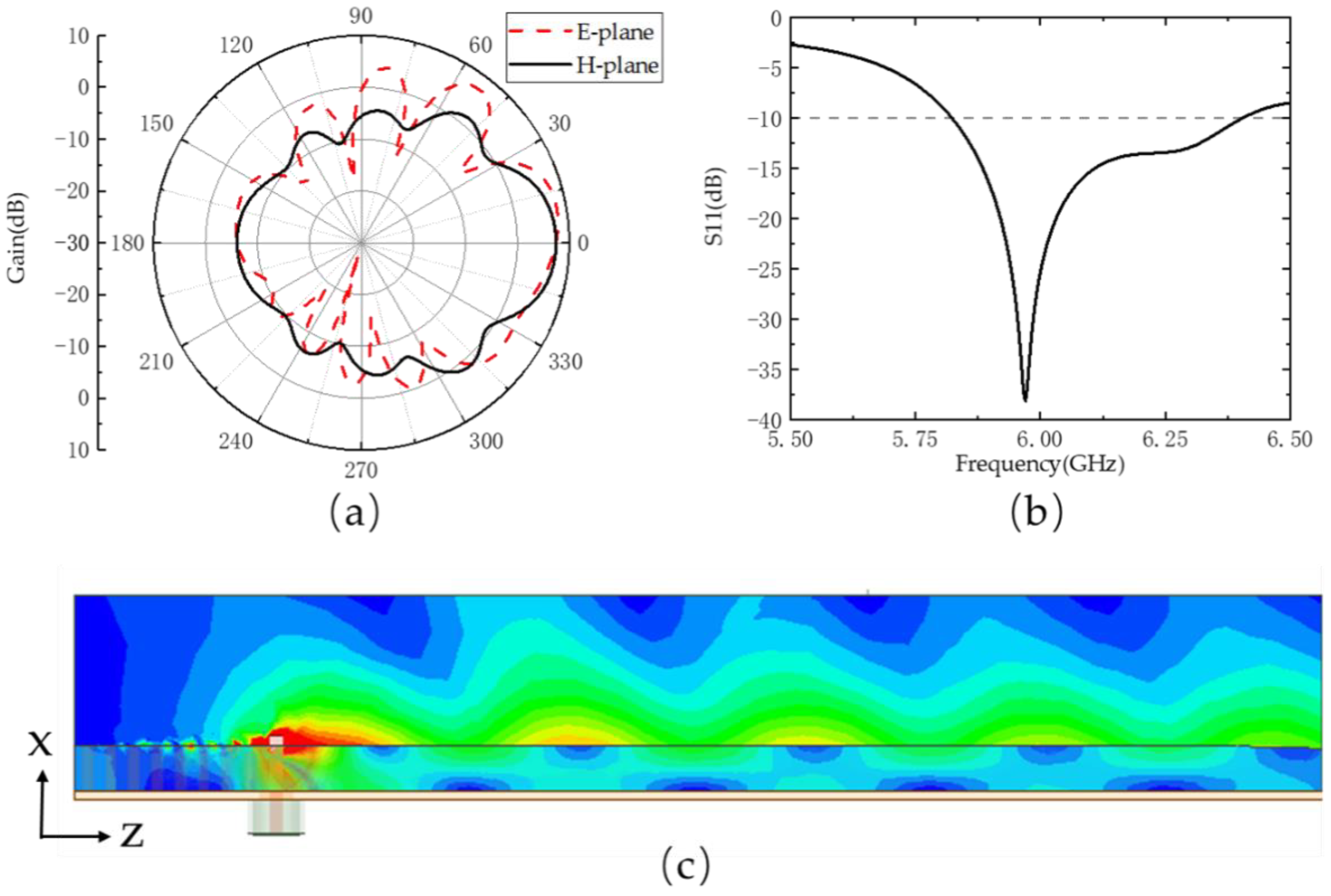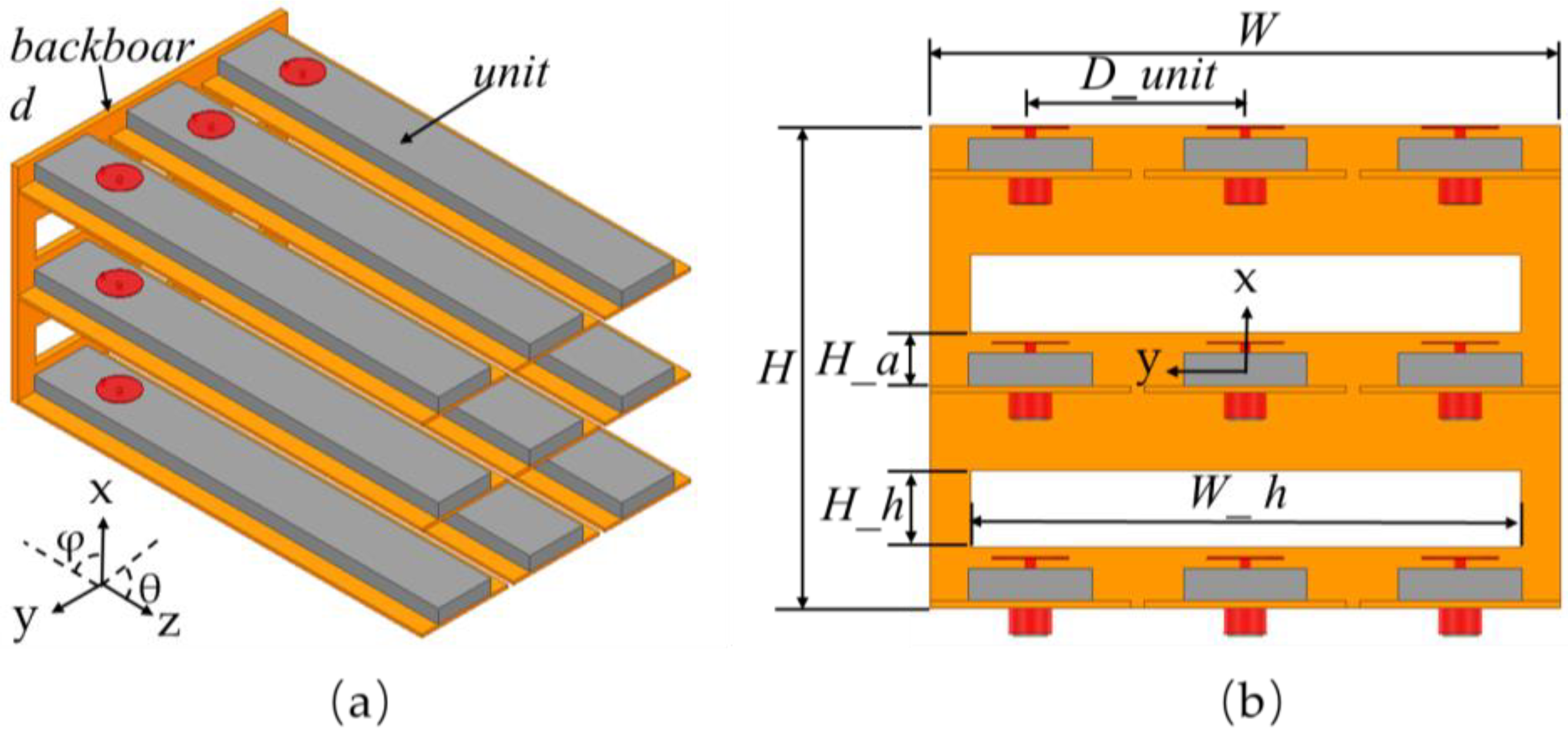Design of Ultra High Aperture Efficiency Surface Wave Antenna Array Based on the Three-Dimensional Aperture Principle
Abstract
1. Introduction
2. Three-Dimensional Aperture Principle
3. Antenna Design and Analysis
3.1. Surface Wave End-fire Antenna Element
3.2. High Efficiency 3 × 3 Array
4. Conclusions
Author Contributions
Funding
Data Availability Statement
Conflicts of Interest
References
- Das, S.; Mandal, D.; Kar, R.; Ghoshal, S.P. A Generalized Expression of Directivity for Planar Antenna Arrays. In Proceedings of the 2013 Annual IEEE India Conference (INDICON), Mumbai, India, 13–15 December 2013; pp. 1–3. [Google Scholar]
- Deng, N.; Haenggi, M. A Novel Approximate Antenna Pattern for Directional Antenna Arrays. IEEE Wirel. Commun. Lett. 2018, 7, 832–835. [Google Scholar] [CrossRef]
- Das, S.; Mandal, D.; Ghoshal, S.P.; Kar, R. Generalization of Directivity Expressions for Antenna Arrays. IEEE Trans. Antennas Propag. 2017, 65, 915–919. [Google Scholar] [CrossRef]
- Wu, Y.-W.; Hao, Z.-C.; Miao, Z.-W. A Planar W-Band Large-Scale High-Gain Substrate-Integrated Waveguide Slot Array. IEEE Trans. Antennas Propag. 2020, 68, 6429–6434. [Google Scholar] [CrossRef]
- Abdel-Wahab, W.M.; Al-Saedi, H.; Raeis-Zadeh, M.; Alian, E.H.M.; Ehsandar, A.; Chen, G.; Palizban, A.; Ghafarian, N.; El-Sawaf, H.; Nezhad-Ahmadi, M.R.; et al. Affordable Large Scale Active-Phased Array Antenna for Ka-Band Mobile SATCOM Applications. In Proceedings of the 2019 13th European Conference on Antennas and Propagation (EuCAP) 2019, Krakow, Poland, 31 March–5 April 2019; Volume 4. [Google Scholar]
- Wei, C.; Zhang, Z.-Y.; Wu, K.-L. Phase Compensation for Decoupling of Large-Scale Staggered Dual-Polarized Dipole Array Antennas. IEEE Trans. Antennas Propag. 2020, 68, 2822–2831. [Google Scholar] [CrossRef]
- Wang, B.; Zhao, Z.; Sun, K.; Tao, T.; Yang, X.; Yang, D. Low-Profile High-Aperture-Efficiency Air-Filled Substrate Integrated Cavity Antenna Array. Antennas Wirel. Propag. Lett. 2022, 21, 1442–1446. [Google Scholar] [CrossRef]
- Tao, Z.; Jiang, W.X.; Ma, H.F.; Cui, T.J. High-Gain and High-Efficiency GRIN Metamaterial Lens Antenna With Uniform Amplitude and Phase Distributions on Aperture. IEEE Trans. Antennas Propag. 2018, 66, 16–22. [Google Scholar] [CrossRef]
- Gholami, M.; Amaya, R.E.; Yagoub, M.C.E. A Compact and High-Gain Cavity-Backed Waveguide Aperture Antenna in the C-Band for High-Power Applications. IEEE Trans. Antennas Propag. 2018, 66, 1208–1216. [Google Scholar] [CrossRef]
- Kang, E.; Hur, J.; Seo, C.; Lee, H.; Choo, H. High Aperture Efficiency Array Antenna for Wireless Power Transfer Applications. Energies 2020, 13, 2241. [Google Scholar] [CrossRef]
- Dai, L.; Xie, Y.; Wang, H.; Wu, P. Three-Dimensional Aperture Principle for End-Fire Radiation Antenna Array. AIP Adv. 2021, 11, 025116. [Google Scholar] [CrossRef]
- Dai, L.; Xie, Y.; Wang, H. A Low-Profile End-Fire Conformal Surface Wave Antenna with Capacitive Feed Structure. Sensors 2020, 20, 7054. [Google Scholar] [CrossRef] [PubMed]
- Zucker, F.J. Surface-Wave Antennas. In Antenna Engineering Handbook, 4th ed.; Volakis, J.L., Ed.; McGraw Hill: New York, NY, USA, 2007; pp. 263–265. [Google Scholar]
- Andersen, J.B. Radiation from surface-wave antennas. Electron. Lett. 1967, 3, 251–252. [Google Scholar] [CrossRef]
- Forman, B.J. A Novel Directivity Expression for Planar Antenna Arrays. Radio Sci. 1970, 5, 1077–1083. [Google Scholar] [CrossRef]
- Zucker, F.J. Theory and Applications of Surface Waves. Nuovo Cim. 1952, 9, 450–473. [Google Scholar] [CrossRef]
- Southworth, G.C. Certain factors affecting the gain of directive antennas. Bell Syst. Tech. J. 1931, 10, 63–95. [Google Scholar] [CrossRef]
- Sandhu, A.I.; Arnieri, E.; Amendola, G.; Boccia, L.; Meniconi, E.; Ziegler, V. Radiating Elements for Shared Aperture Tx/Rx Phased Arrays at K/Ka Band. IEEE Trans. Antennas Propag. 2016, 64, 2270–2282. [Google Scholar] [CrossRef]







| Parameter | Value (mm) | Parameter | Value (mm) |
|---|---|---|---|
| L | 110 | D_f | 16 |
| H_d | 3.8 | H_pin | 4.9 |
| W_d | 14.3 | R_pin | 0.5 |
| W_g | 23.4 | R | 4.5 |
| Reference | Operating Frequency (GHz) | Three-Dimension Size (mm) | Aperture Efficiency |
|---|---|---|---|
| [9] | 5.8 | 114 × 74 × 28 | 95% |
| [10] | 5.8 | 75 × 75 × 57.6 | 74.2% |
| [18] | Ku | 52.5 × 52.5 × 3.52 | 58% |
| [7] | 10.5 | 148 × 296 × 12.6 | 86.1% |
| [8] | 14.25 | 131 × 131 × 300 | 93.9% |
| This work | 6 | 75 × 75 × 112 | 120% 1 |
Publisher’s Note: MDPI stays neutral with regard to jurisdictional claims in published maps and institutional affiliations. |
© 2022 by the authors. Licensee MDPI, Basel, Switzerland. This article is an open access article distributed under the terms and conditions of the Creative Commons Attribution (CC BY) license (https://creativecommons.org/licenses/by/4.0/).
Share and Cite
Pang, K.; Xie, Y.; Dai, L.; Wu, P. Design of Ultra High Aperture Efficiency Surface Wave Antenna Array Based on the Three-Dimensional Aperture Principle. Electronics 2022, 11, 3515. https://doi.org/10.3390/electronics11213515
Pang K, Xie Y, Dai L, Wu P. Design of Ultra High Aperture Efficiency Surface Wave Antenna Array Based on the Three-Dimensional Aperture Principle. Electronics. 2022; 11(21):3515. https://doi.org/10.3390/electronics11213515
Chicago/Turabian StylePang, Ke, Yongjun Xie, Legen Dai, and Peiyu Wu. 2022. "Design of Ultra High Aperture Efficiency Surface Wave Antenna Array Based on the Three-Dimensional Aperture Principle" Electronics 11, no. 21: 3515. https://doi.org/10.3390/electronics11213515
APA StylePang, K., Xie, Y., Dai, L., & Wu, P. (2022). Design of Ultra High Aperture Efficiency Surface Wave Antenna Array Based on the Three-Dimensional Aperture Principle. Electronics, 11(21), 3515. https://doi.org/10.3390/electronics11213515








